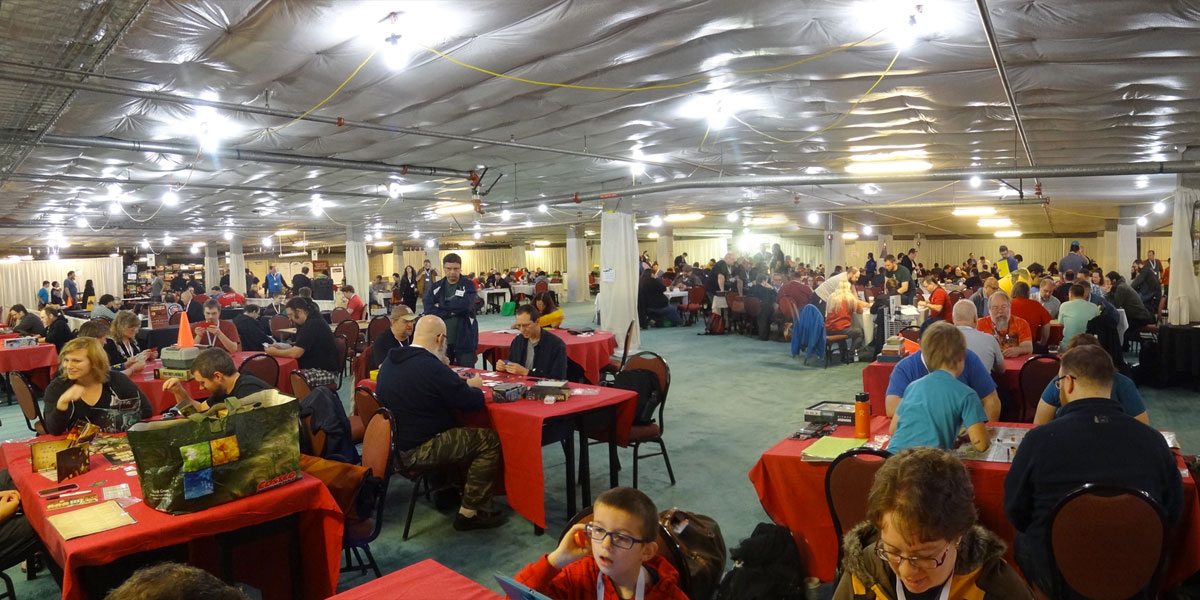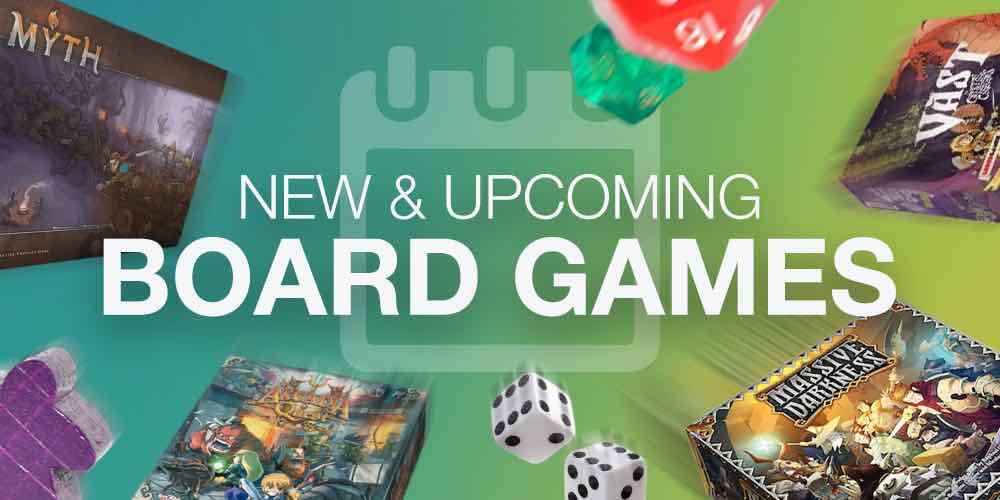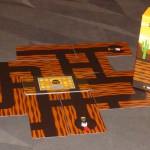
Last weekend I attended GameStorm, a local gaming convention here in the Portland/Vancouver area. It’s held at the Vancouver Hilton and one of the features is 24/7 open gaming throughout the whole weekend. While I didn’t stay to play games overnight, I did get a lot of gaming in over the weekend. Here’s a recap of some of the games I played and a little about the experience.
This year, due to a double-booking error at the hotel, some of the ballrooms normally used by GameStorm were unavailable on Thursday, so instead they were given the use of the parking garage. A lot of attendees (including myself) were a bit concerned about this: what was it going to be like? Was it going to be cold? Dingy? I figured that if it was too horrid, I’d just camp out and have my own BasementCon.

As it turns out, the garage was pretty great. They put down carpet, covered the pillars, hung curtains and strung up lights. If you were in the middle of the room, you could barely tell you were in a garage unless you looked up–but who does that during a gaming convention anyway? It was pretty comfortable and well-lit, and actually felt less noisy than previous years in the ballrooms.
The only downside was that it was pretty inconvenient getting between the garage and the first floor. The stairs to the first floor went to an exterior exit-only door, and the elevator closer to the first floor bathrooms kept breaking down over the weekend. From inside, if you didn’t want to wait for the elevator, you had to take the stairs up to the first floor, then go down the fire stairs to the basement. Stopping for a bathroom break would take ten minutes just for transit time.
There were other events on the first and second floor, too: a small dealers’ room had some booths for a local game store, custom dice, RPGs, and more. Most of the RPGs were also spread out on these two floors, and there was one room reserved for various panels (and a Doubleclicks concert) throughout the weekend. But when I go to GameStorm, it’s all about playing games–I camped out most of the weekend down in the garage and just played as many games as I could.
Day One:
I arrived at the Hilton on Thursday right about noon and got checked in. Then I went to check the garage, and found a dad sitting down to play Machi Koro with his two sons. I wasn’t quite ready to play just yet because I needed to eat lunch, but I did get a chance to teach them how to play. It included the Harbor expansion, which I got recently and have really enjoyed. More on that one soon!
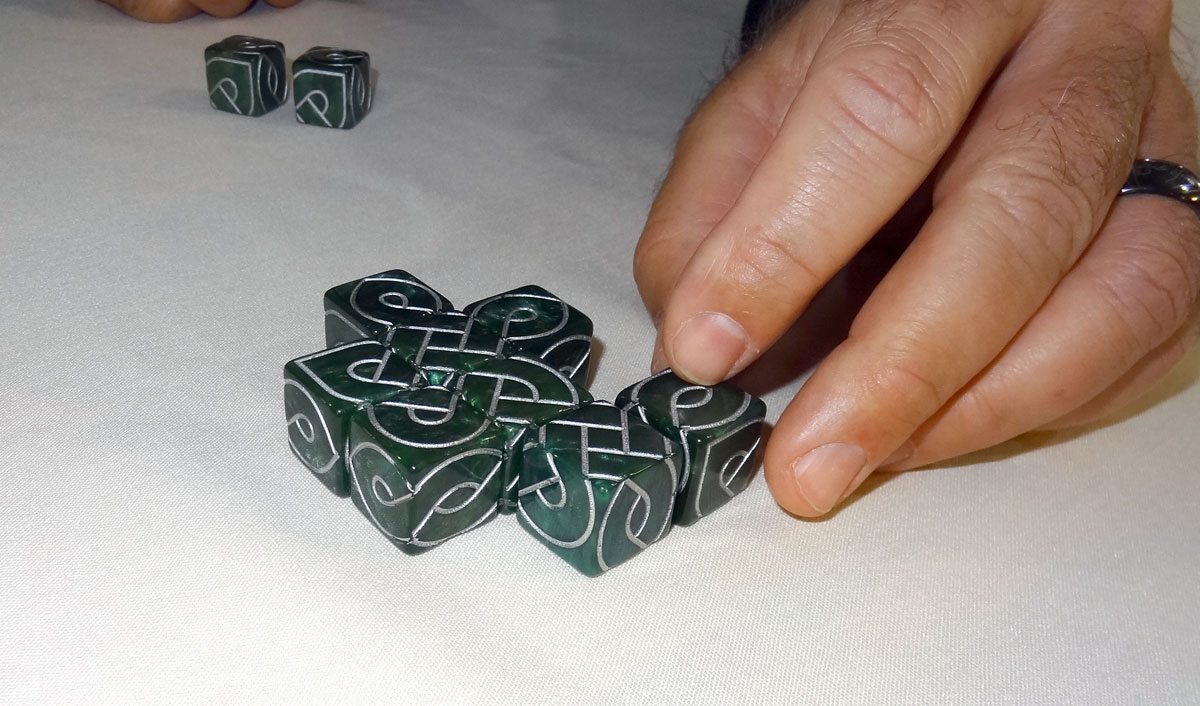
After my brown-bag lunch, I kicked off my gaming with a couple rounds of Knot Dice by Matthew O’Malley. Knot Dice are beautiful green dice with Celtic knot patterns on them, and they’ll be on Kickstarter soon. There are a couple different games you can play with them–some cooperative, some competitive, and even a real-time game. If you like custom dice, these are really gorgeous, though because of the nature of them you can’t use them as substitutes for most of your other games. There will be more games for the dice by other designers, so I’m looking forward to seeing what else there is.

Tessa van Boxtel from Board Game Duel brought her copy of Pandemic: The Cure, which I’d never played before. We had a five-player game, and I enjoyed it. It’s an interesting system, with dice rolls taking the place of drawing infection cards–it means that you can’t predict the coming infections each time an epidemic happens. The roles are all familiar from the original game, though tweaked to work with this system. I do miss the map a little, but it’s one I’d definitely be interested in trying some more.
I’d signed up to try Terra Mystica, but unfortunately they’d started playing already so it’ll have to stay on my “to play” list a little longer.
After this I played a couple games that I forgot to take pictures of: Splendor, which was at the top of several lists for 2014–we checked it out of the GameStorm library. I’m still not entirely sure what I think of it. It’s an abstract set-collection sort of game, and from what I can tell it seems like what people really love about it are the heavy plastic chips. I actually got a copy for myself through a math trade, so I can try it some more–but so far mostly what I’ve learned is that I’m really bad at it.
I also played a couple games of Star Realms, which is a really great space-themed deck-building game. It’s an interesting model that’s more a la carte: you can get enough cards for two players for only $15, or get two sets to play up to four players. The expansions are generally small packs that are fairly inexpensive, and you can upgrade from the tuckbox to a nicer two-part box for $20. It’s a fast-playing spaceship combat, and we played with the Gambit expansion. I still haven’t played it with more than 2 players, but I do enjoy it quite a bit.

We followed this up with another prototype for an upcoming Kickstarter: Vikings of Dragonia. You play as Vikings, traveling across the seas to claim islands. Each island you occupy will earn income, but is also worth points … until you lose control of them. Meanwhile, there’s a dragon who can fly around and attack you, or at least prevent you from earning income if it’s nearby. I did get a couple rules wrong, so I’ll have to give this one another shot sometime before the Kickstarter launches in May.

Then I played a round of Best Treehouse Ever, a cute card-drafting game that’s on Kickstarter right now! You draft rooms, add them to your treehouse while keeping your tree balanced, and then manipulate the scoring so that your treehouse is worth the most points. It’s a lot of fun and I played it more than once this weekend–you can read my full review of it here.
Another one that missed its photo opp: Between Two Cities, which wrapped up its own Kickstarter last week. I brought my review prototype because it’s a great game for a wide range of players, and we had a good time with it. Missed the Kickstarter? You still have time to place a pre-order.
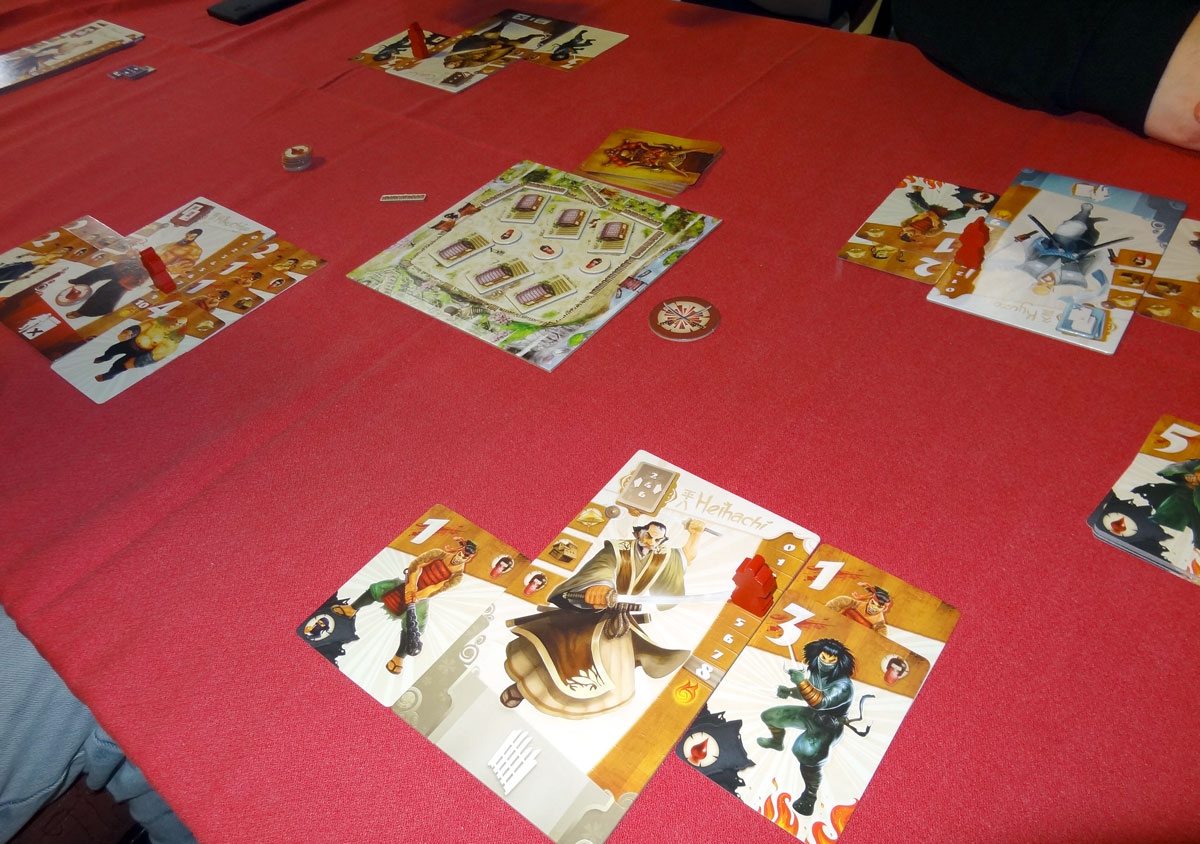
I’ve got a review copy of Samurai Spirit, a cooperative game by Antoine Bauza inspired by the film Seven Samurai. It’s an interesting game about trying to manage your risks–if you take two wounds, you’ll unleash your animal spirit and become stronger, but two more wounds after that and you’ll die and everyone loses. Turn into an animal too soon, and you may die. Avoid taking wounds and stay in your human form, and the village may burn down. We actually managed to win the second time around … though I learned on Sunday (on my third play of the game this weekend) that I’d been cheating on one of the rules. So we’ll call it a win with an asterisk. Watch for a full review of this one soon.
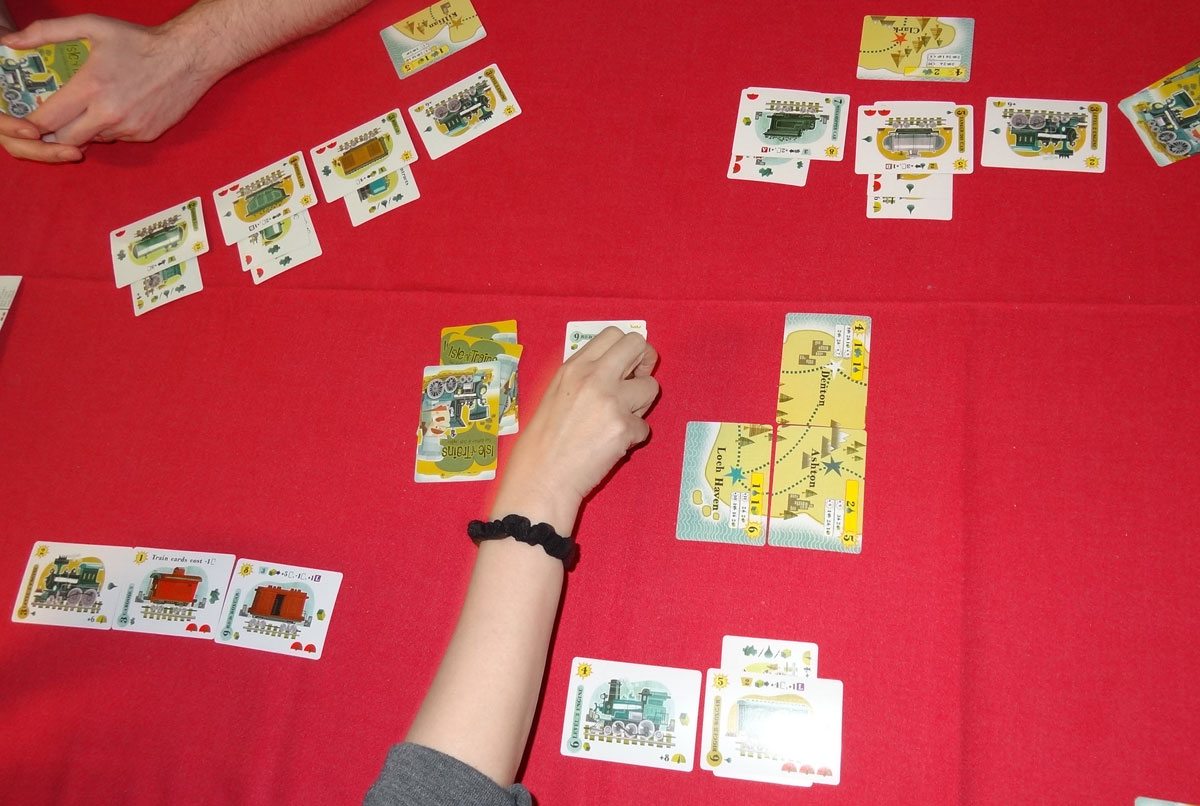
I’d brought along my set of all six Dice Hate Me “Rabbit” Games–small card games from the Kickstarter project. I’d backed the project but hadn’t played any of them, and I figured this would be a good weekend to give them a shot. I only got two of them to the table this weekend. First up was Isle of Trains, by Dan Keltner and Seth Jaffee. You spend your cards to build a train, which can then be loaded with cargo, which in turn is used to fulfill contracts. You’ll get points for the trains, cargo, and contracts at the end of the game. As you can see from the photo above, my train (bottom right) is really not doing so well–I invested early in a better locomotive, but then couldn’t afford to build anything else for a while. It’s a much heftier game than I had expected, and I’m going to need to try it again now that I know what I’m doing. Fun fact: I’d heard there was an error on one of the cards and I tweeted to find out what it was, and then Seth Jaffee himself showed up at our table to answer us. That’s some great service right there.

Next up was Roll for the Galaxy–it’s a dice version of Race for the Galaxy, which I’ve played a couple times before but have never really gotten into. It’s an interesting trend, taking games and making dice-based versions of them (like Pandemic: The Cure) and it’s always fun to see how they make the transition. Roll for the Galaxy is about colonizing planets, developing technology, and using these to score points through producing and trading. I enjoyed it even though I lost and definitely needed a better strategy.
Another game I’d signed up to play was A Study in Emerald, a cooperative deck-building game based on the short story of the same name by Neil Gaiman. It had a small print run and is now really hard to find–but unfortunately I was number 12 on the list and the game only goes up to five players. Enough people showed up to play, so I’ll have to try again some other time. That, or pay an exorbitant price on eBay for a copy for myself.

I finished out Day One with my own game, Emperor’s New Clothes. Michael Mindes (of Tasty Minstrel Games) and Seth Jaffee had expressed some interest in trying it out, so I got out my deluxe copy (complete with custom PennyGems) and we had a fun time with it. Mindes was one of the guests of honor at GameStorm and I got to hang out and play several games with him over the course of the weekend. My personal triumph was finally getting him to smile that first day–he seems pretty picky about games (a good quality in a publisher, I would guess) but I think he saw something in Emperor’s New Clothes. (Enough so that we played it again later in the weekend.)
Day One: Elapsed time, roughly 12 hours. Games played: 12 different titles.
Day Two:
After a rough night in which a smoke detector started complaining about low batteries in the middle of the night, thus setting off the house alarm, thus triggering a phone call from the alarm company, thus waking up my daughter … I got back to Gamestorm about 9 and dove back in.
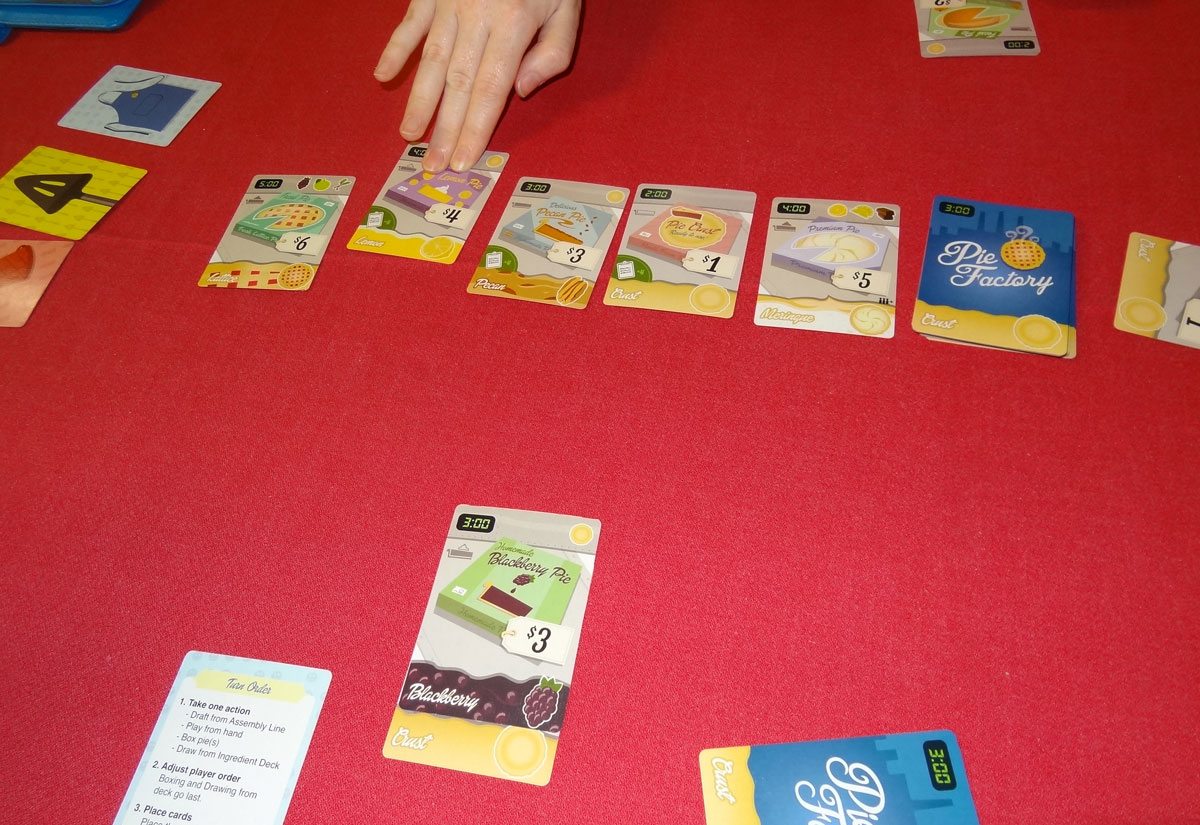
First game of the day: Pie Factory, another Rabbit title from Dice Hate Me Games. You pull ingredients off the conveyor belt, make them into pies, and then box them up and sell them. Fancier pies bring in a better price, but take longer to make–and the player turn order is determined by how long your pie-making takes. This one is a bit lighter than Isle of Trains–fun, but not quite as deep.
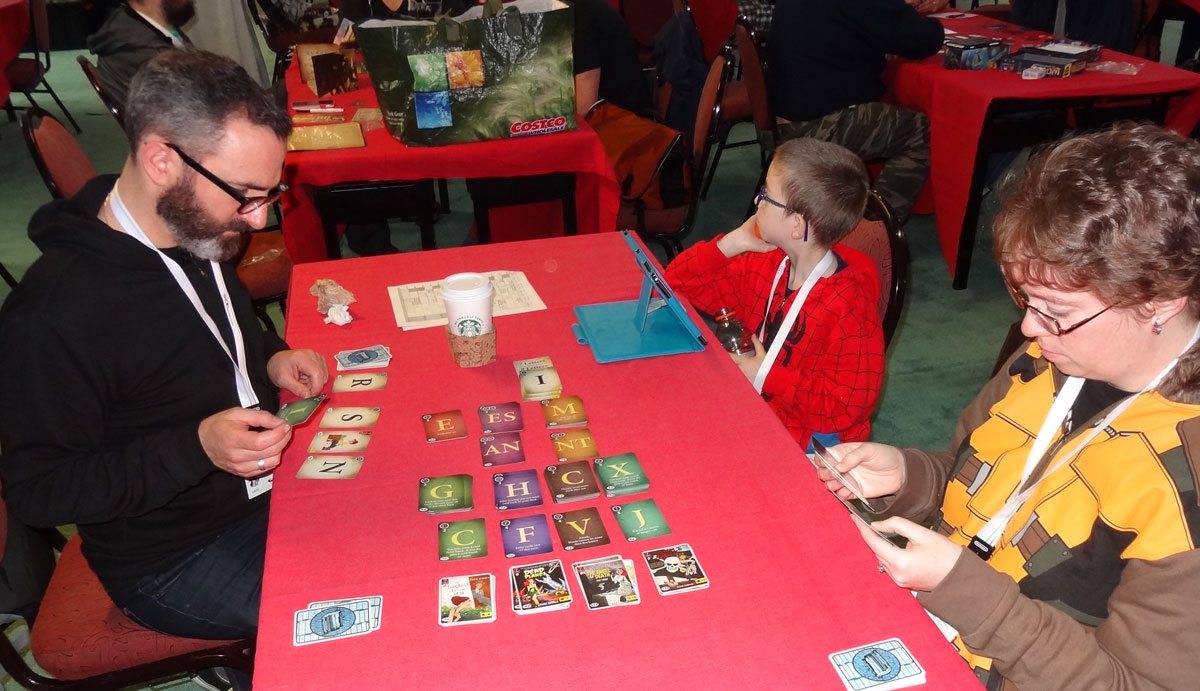
Next up was Paperback, a deck-building game by Tim Fowers that I describe as Dominion meets Scrabble. Your deck is made up of letters and letter pairs; you spell words with the cards in your hand to earn money to buy new letters. Many of the cards have special abilities, too, that may let you draw more cards, earn more money, or even interfere with other players. I’d written up the game when it was on Kickstarter, and the finished product turned out quite nicely. I ended up playing this twice over the weekend. (You can buy a copy directly from Tim Fowers’ website, or if you back his current Kickstarter for Burgle Bros., you can add on a copy of Paperback for $25.)

I finally made it to a game that I signed up for: AquaSphere. It’s a game by Stefan Feld, known for a particular style of games that tend to melt your brain a little. It was brought to the US by Tasty Minstrel Games through a successful Kickstarter campaign last summer, and I figured this would be a good chance to learn it without having to muddle through the whole rulebook myself. The players are scientists on an underwater research station, programming bots to do various tasks like launching submarines and capturing the meddlesome Octopods. There’s a whole lot going on in this game and it can feel a bit overwhelming at first, but I liked it. I’m hoping to get my copy to the table again soon so I can write a full review, but since it’s a longer game (about two hours when I played) it’ll depend on having the right group for it.

If you like really hard cooperative games, Ghost Stories may be the game for you. Another one by Antoine Bauza, this game starts off looking pretty easy. You flip over a ghost card, add it to a board, and then take turns trying to clear out the ghosts before they take over the village in the center. But pretty soon you start getting overrun, losing your qi, and the next thing you know the village has been lost before you’ve even gotten to Wu-Feng, the big bad boss. At least, that’s how it generally goes when I’ve played it. One of these days, though, I’m going to prevail. Maybe.

Homesteaders is the first title that Tasty Minstrel Games published, and it’s out of print now. Michael Mindes and I joined in a game that was just setting up. It’s pretty cool: you build up your town, hire workers to work in the places you’ve built, and bid for the privilege of building various types of buildings. It’s another game with a lot going on, but it’s excellent once you learn how it works. (Mindes beat us all pretty handily–apparently he has a really good track record with Homesteaders.)
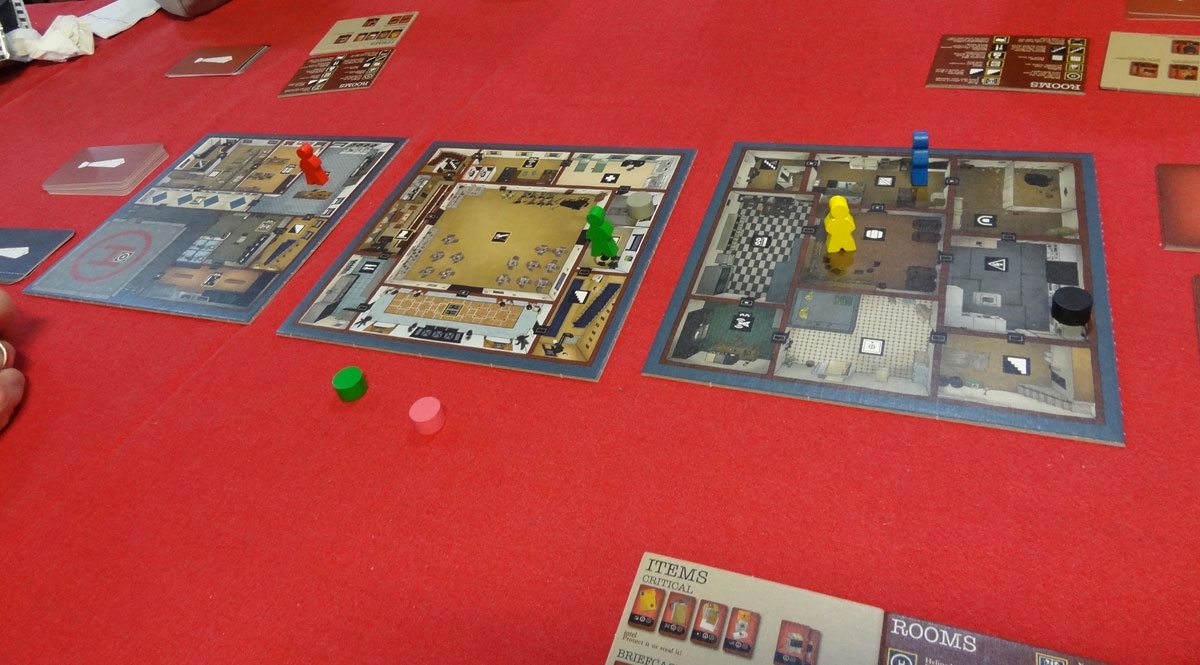

Time for another small game: Harbour, another game funded last year on Kickstarter by Tasty Minstrel Games. (My original review is here.) It’s another game by Scott Almes–think of it as Tiny Epic Le Havre. You send your one worker to various buildings around this little portside town to collect resources, manipulate the market, and buy buildings. It’s a clever game that’s very compact but has a lot going on. We played the easy version without the special player powers, but I’d love to try those next.

I finished up the second day with a 2-player game of Alien Frontiers. It’s been a while since I’d played it, and a friend of mine had been itching to play it. We hadn’t read the rules for any of the expansions yet, so we just went with the base game, though his copy had the fancy little colonies, which were fun. It’s a worker-placement game, except that your workers are dice, and you have to get the right numbers or combinations to place them in various locations. Honestly, I’d forgotten how cutthroat the game could get, but I enjoyed crushing my opponent with superior alien technology. If you’re looking for a copy, there are just a couple hours left on the Alien Frontiers Big Box Kickstarter: get the whole shebang for $125.
Day Two: Elapsed time, roughly 15 hours. Games played: 8 different titles.
Day Three
I got back to GameStorm around 9 again on Saturday, ready to play some more. My first game was another round of Paperback–I bumped into a couple who only had a free hour and were puzzling over the rules to [redacted], but realized they probably didn’t have time to learn and play it just then.

Then I broke out Tiny Epic Kingdoms, another Kickstarter success I’d reviewed and backed. It’s a 4X game: explore, expand, exploit, exterminate. You take on various fantasy races, each with its own special abilities, and try to score the most points through various means. What’s interesting is the way that you can try lots of different things to score points: build up your tower, advance your magic skill, or just expand into lots of territories. With so many races to choose from, there’s a lot of replay value. But I gotta say, the Order of Gamelyn (named after the publisher, Gamelyn Games), seems a bit overpowered. I need a rematch.
Not pictured: a friend of mine had picked up Legendary, the cooperative Marvel-themed deck-building game, and I mentioned that it really helps to have several people sort out the cards the first time you open up the box. So we did that, and then played. We went for the easiest Mastermind, Red Skull, and won, though there was a tense moment in the middle when it seemed like we were going to get overrun. The scheme we played was “replace the world’s leaders with Killbots,” which was pretty entertaining. The Marvel-based one seems to be easier than the Alien-themed Legendary Encounters, but I still enjoy it.

I’d taken along several of the demo prototypes I had for current and recent Kickstarter games, and we played a round of Seven7s. I’m still impressed with how clever the game is–at first glance it seems like it’s just random, but then you realize how the cards work together and how you can manipulate your score (or your opponents’) with carefully chosen moves. You’ll have to wait a while for a finished copy, though, since the Kickstarter just closed recently.
Then we had another round of Emperor’s New Clothes–Michael Mindes wanted to show a friend of his, and this time we had a lot of players. It definitely gets pretty chaotic when you have so many people but it’s still fun. I don’t even remember who won, but that’s not really the point.
About this time I managed to get upstairs and tracked down Mike Selinker, because I’d heard he had some info about his new/old adventure card game. There were three tables of people playtesting an upcoming Pathfinder Adventure Card Game set, but I found Selinker playing another upcoming game, Epic vs. Awesome. His company, Lone Shark Games, has worked with other publishers in the past, but announced last week that it’s going to start publishing some of its own titles. Among them are a few party games like Epic vs. Awesome, which challenges players to come up with the most epic or awesome answer based on some criteria set by the cards. It’s a little bit Apples to Apples, a little bit Scattergories.
What I really wanted to hear about, though, was Apocrypha. It’s Selinker’s adventure card game–originally known as Saints, it eventually became the Pathfinder Adventure Card Game. But Selinker had created his own world for Saints, a dark urban fantasy, and still wanted to create that game. I got to see some of the artwork and a little bit of how the game will work–there are some similarities to PACG but also some significant differences, and I’m eager to try it when it’s ready. I’m hoping to have more details on this soon, but expect a Kickstarter launch this year.

Glen More is an older game that my friend Rael brought with him. It’s a tile-laying game, of sorts–each player builds their own little village. The trick, though, is how you acquire those tiles. They’re placed in a ring on this center board, and the last player in line gets to move to any tile and collect it. If they’re still in last place, they get to keep going–kind of like Tokaido. Placing a tile lets you activate the ones around it, gaining you resources that are then spent to build other tiles. Unfortunately, this one is hard to find now.

Isaias Vallejo, designer of Sunrise City and Valeria: Card Kingdom, came to GameStorm to run demos of Valeria throughout the weekend, and I was excited to meet him in person. I’m a fan of both of his games and enjoyed getting to play a game with him. You can read my full review of Valeria here–the Kickstarter campaign hit funding over the weekend and is working on stretch goals now. It’s such a good game.

I ended Saturday with Shadows of Brimstone, a massive game from Flying Frog Productions. It’s probably the priciest thing I’ve backed on Kickstarter myself, and the first time I’ve tried painting any miniatures–though so far I’ve only gotten four of the heroes, and none of the monsters yet. I figured GameStorm was a good opportunity to get out something long and involved. But I hadn’t quite realized how long and involved. The first two times I’d played Shadows of Brimstone, it had been closer to an hour and a half–we got lucky the first time because we found the clues early, and the second time we all got knocked out so the scenario ended. This time, we had to delve deep into the mines to find our objective, and the game took about four hours, going well past midnight. But it was a blast, and I really want to play it some more. I also want to finish painting up my miniatures.
Day Three: Elapsed time, roughly 18 hours. Games played: 8 different titles.
Day 4
The last day of GameStorm was a little shorter–for one thing, I slept in and didn’t get there until after 11, and the garage gaming room was scheduled to close at 4. I didn’t find out until later that there was still gaming on the first floor open the rest of the evening, but I’d already arranged to head home.
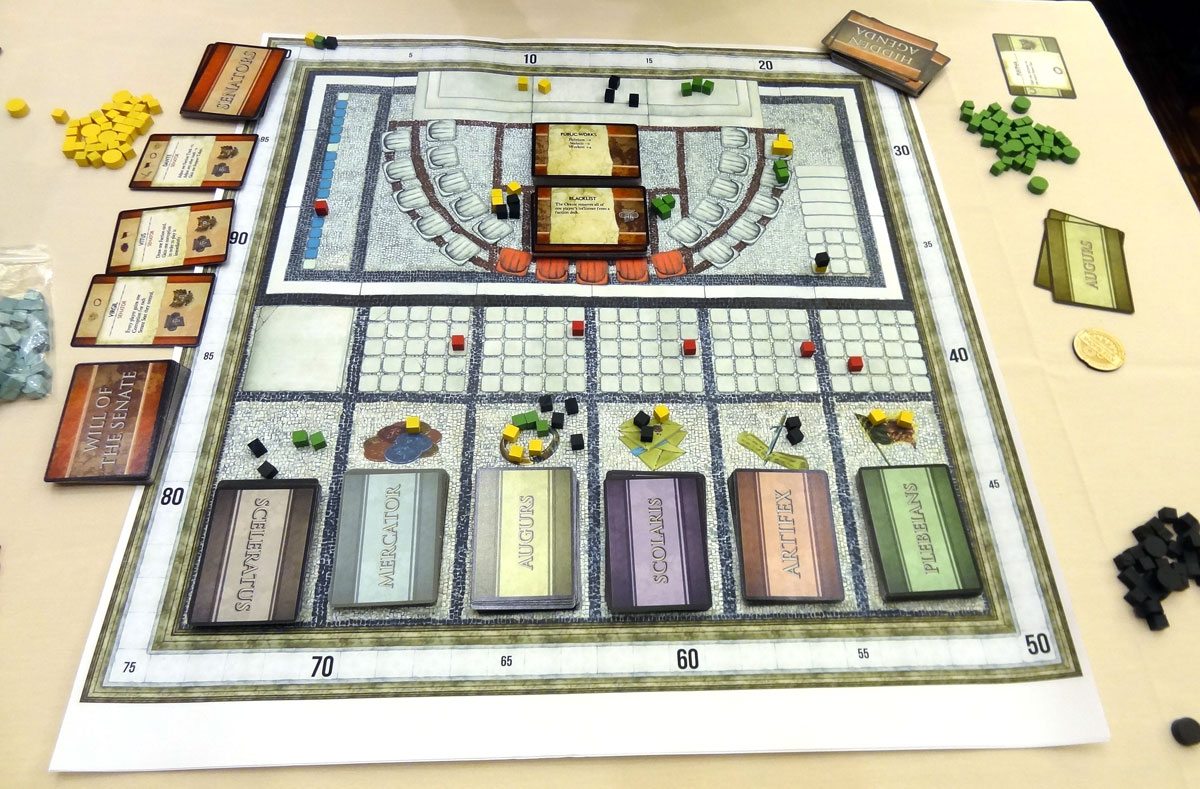
My first stop, though, was to the Dealers’ Room. I hadn’t spent much time there, but I’d been told to check out a couple of prototypes there. One I can’t tell you about yet (it’s still waiting on a contract), but the other I tried was 100 AD, designed by Jim Pinto. It’s based on the Roman Senate, and you’re trying to gain influence over senators, various factions, and even the emperor himself. You can pull a lot of fun shenanigans, at the cost of corruption points. You lose points for having too much corruption, but you may be able to take some powerful actions that will gain points in other ways. I really enjoyed this one–expect a full review when it hits Kickstarter later this year.
I followed that with another round of Best Treehouse Ever and then Samurai Spirit (we lost in Round Two). And then, for the last game of the convention, I broke out Legendary Encounters. We played the setup based on the second movie, Aliens, and though we managed to accomplish our first objective, we got hit hard during the second objective. Face-huggers everywhere. I think three of us got hit by them in a single round, and though we did manage to prevent them from turning into chestbursters, we wound up with too many other aliens. First we lost our medic, and it spiraled downhill from there pretty quickly.
Day Four: Elapsed time, 5 hours. Games played: 5 different titles.
All in all, a pretty good weekend of gaming. As always, there were lots of things I missed. Keith Baker was there running demos of his upcoming role-playing game, Phoenix, and I didn’t attend any panels. This year I also didn’t spend any time in the Game Lab playing prototypes since I had so many of my own to review, but it’s another great way to try out lots of prototypes, give feedback to the designers, and win some prizes while you’re at it.
I didn’t run any scheduled games myself, though I did spend much of the weekend teaching games that I want to review (or just ones that I own), so maybe next year I’ll see if I can get myself organized in time to run some scheduled games. Maybe I can set up a “play games with GeekDad” table?
You can register for Gamestorm 18 already–the earlier you register, the lower the price. Currently memberships are on sale for $25 for a weekend pass.
